Court Views 1977 Video Footage of 1st January Dam
On trial day 62, of Case 002/02, the Trial Chamber continued with the examination of witness Meas Layhuor. Her testimony was apropos to ascertaining the truth about the allegations of crimes against humanity having been committed at the 1st January Dam worksite on which she had worked during Democratic Kampuchea.
Forced marriages
Senior Assistant Prosecutor, Vincent de Wilde, picked up the thread of his questioning from the day before by enquiring of Meas Layhuor whether people could choose to get married without the authorization of Angkar and the village chief. (Angkar, meaning “the organization,” was the Khmer Rouge ruling body).
“No,” Ms. Meas said, “only when it was arranged by Angkar did it happen.”
During DK, customary marriages were forbidden. If you were a “base person” (someone who had joined the revolution before April 17, 1975), Angkar would chose a potential partner and ask whether that person would like to get married or not.
“I was a base person and so was my husband,” she said. “My mother and the mother of my husband agreed, but it was Angkar who arranged our marriage.” Earlier in the regime, “our parents had tried to marry us but they could not.” Ms. Meas explained that her marriage initially was refused by Angkar because her husband was a teacher and they were both considered petit bourgeois. But, later, towards the end of DK, she was able to marry him in a ceremony led by Angkar for her and 25 other couples.
After the marriage, militia men spied on the newlyweds for the first few days to see if they conducted any religious rituals to celebrate the nuptials such as making offerings to her ancestors, Ms. Meas revealed to Marie Guiraud, International Civil Party Lead Co-Lawyer. “If we were found doing that, we would be taken away and killed,” the witness said.
Ms. Guiraud asked if divorce was possible under the Khmer Rouge. Meas Layhuor was not aware of any divorces. “After the marriage was arranged by Angkar, they did not dare to get divorced. If they dared to get divorced, they would be killed by Angkar.”
For the “new people” (those who had been deported from Phnom Penh and were “new” to the revolution and to the villages in which they had been “deposited”), marriages were imposed. Angkar would match a woman with a man. Ms. Meas recounted that there was no marriage due to a proposal between the parties.
Cham people were also forced to marry among themselves, again with Angkar choosing the brides and grooms.
New people were not allowed to marry base people; Cham people could not choose to marry Khmer people, either. People “from different backgrounds could not get married,” Ms. Meas reported.
Video evidence from 1st January Dam
When Mr. de Wilde wanted to show Meas Layhuor two photographs and two videos purported to be of the 1st January Dam, Victor Koppe, defense counsel for Nuon Chea, objected on the basis that there was no evidence that the video excerpts were actually of the 1st January Dam. Mr. de Wilde countered that one of the reasons why the videos should be shown was in order that the witness could confirm that the footage was from the 1st January Dam.
When the court allowed the viewings, Ms. Meas immediately recognized the infrastructure as belonging to the 1st January Dam: “The dam I saw in the film is the 1st January Dam,” she said, “and the main feature I recognize is the main spillway.” She went on to identify the celebration at the end of the clip as the opening of the spill way. There had been visitors, and she was among the people who had been instructed to greet them.
Mr. de Wilde then showed another video of people running while carrying stones.
Again, Ms. Meas recognized the footage as of the 1st January Dam. She negated that it was the 6th January Dam because that dam was shallower and the clip showed how deep the 1st January Dam was.
When Mr. De Wilde enquired as to why people were running in the video, Ms. Meas elaborated that “when there were visitors, we were told run so that they would see us proactive in our work.”
Cross-examination
Victor Koppe, International Defense Counsel for Nuon Chea, was given the floor to begin the cross-examination of Meas Layhuor.
Forced Marriages
Mr. Koppe’s first point of contention was with the witness’s prior statement that Ri, one of her friends who had undergone a forced marriage during the regime, divorced soon after. The prosecution had let the statement stand as evidence that, as soon as the Khmer Rouge fell, people who had been forced into marriage then divorced. The lawyer pressed the witness as to why and when Ri had been divorced. Ms. Meas could not recall exactly when but told Mr. Koppe that Ri had had two or three children after the regime fell and before she got divorced “because her husband had a mistress.”
Dying from Dysentery
Mr. Koppe went on to investigate Meas Layhuor’s evidence that many people had died at the 1st January Dam because of dysentery. Mr. Koppe read in from the testimony of prior witness TCW-855, Kang Ut (phonetic transcription), that a number of people had got sick at the worksite, but that they had been treated and those that were seriously sick had been sent to a faraway hospital. “No one wanted to be left dead at the site,” (sic, translation?) Mr. Kang had avouched. Ms. Meas confirmed that no one was “left dead at the site” because those that were seriously sick would be sent to the district hospital in Baray, about 10 kilometers away. No one in her unit had got seriously sick.
Mr. Koppe followed up with asking her how she knew then that many people had died from dysentery. “I know it,” she responded “because the unit chief would tell us that this particular person had died because of dysentery. I had no relationship with the medic.”
Work Schedule
Meas Layhour affirmed that everyone in the Balangk commune who worked at the 1st January Dam worksite had the same general schedule. They would take rests at the same time when the bell rang and start working again when the bell rang a second time.
Mr. Koppe confronted her with the testimony of another witness, Or Ho, who had appeared before the ECCC last week. The chief of Prey Sneah village, in the Balangk commune, he also had worked at the 1st January Dam. Ms. Meas remembered seeing him there.
Mr. Or had said that there was a lunch break from 11:00 a.m. to 2:00 p.m. while Ms. Meas had said that the lunch break was only from 1:00 p.m. to 2:00 p.m. Ms. Meas recalled that they heard the bell at 11:00 a.m. but had to walk from the worksite to the cafeteria which was far away. At 1:00 p.m. they had to walk back. She contradicted her evidence of yesterday that they did not work all morning without rest by agreeing with Mr. Or’s assertion that there was a 50-minute break in the morning.
Ms. Meas further accepted when it was put to her that they had had to work at night only in exceptional circumstances, not on a regular basis. For example, when a dam wall they were repairing broke, they had had to work day and night. When they were digging canals, they only worked during the day.
Soldiers
After reading in an excerpt from Or Ho’s testimony stating that militia men were not at the dam to watch the workers, Mr. Koppe grilled the witness as to whether the militia men were there perhaps to guard the dam site from external threats.
Marie Guiraud objected to this characterization of Mr. Or’s testimony as Or Ho later had added that the militia men were there to watch the workers, too. Mr. Koppe argued that he was allowed to ask the witness to respond to an excerpt of Mr. Or’s testimony.
Judge Fenz took the opportunity to admonish Mr. Koppe to stop feeding the witness answers. The defense counsel defended his strategy challenging the Bench to define the difference between him reading excerpts from other witnesses and the prosecution reading in from the witness’s own statement. When the jurist answered that it was not the same thing, Mr. Koppe retorted with his usual wit: “I’m learning every day.”
President Nil Nonn overruled the objection and Ms. Meas described that:
“The militia men were there to guard the members of special units when they went into the forest… They were stationed 100 to 150 meters apart. And usually two or three soldiers were assigned to each commune….Their main purpose was to guard us from staying too long in the forest.”
Cages
Anta Guissé, Khieu Samphan International Defense Counsel, questioned Ms. Meas how she knew there was one cage per village. Ms. Meas modified her prior claim. She only knew “that there was one cage for my village. I do not know if there were cages for other villages. I never walked around. I have no idea about other villages.”
Punishment
Mr. Koppe questioned the basis for Meas Layhuor’s conclusion that her friends, Tree and Leep (phonetical spelling), were being punished when Leep was placed in a cage because she did not want to work and that Tree was re-educated because he did not obey orders. Ms. Meas professed that she had not overheard anything although she was there when Tree was taken away. She was told that they were taken away because of the reasons mentioned above by “workers inside the unit. When people disappear, we would whisper. I was busy concentrating doing my work. It was not my job to know.”
Mr. de Wilde objected on the basis that it is a leading (as the answer is embedded in the question), for Mr. Koppe to submit to the witness that the person who told her why Leep and Tree were arrested may have been guessing. The objection was sustained with the President reminding Mr. Koppe that he has to ask questions within the witness’s knowledge.
Mr. Koppe rephrased to ask, if the witness was told by the person, how that person knew what they knew. Ms. Meas responded: “No. I don’t know how he knew. We would whisper to each other and ask why they were being taken away.” When prodded, she admitted that she did not know why Tree and Leep had been disciplined.
Pagoda
The defense counsel moved on to quiz how the witness had learned that people were being killed at the Wat Baray Choan Dek Pagoda when she had never visited or gone inside the pagoda. Ms. Meas testified that “as a normal or ordinary person, I was not allowed to go inside. If I go inside I would be killed.” But she “knew that when music was played, people were getting killed. Everyone whispered to one another. As base people, we could ask the village chief what happened. After they went into the pagoda, they would never return.”
_______
On the conclusion of the testimony of Meas Layhuor, the Chamber called to the stand Civil Party witness Hun Sethany.
According to the ECCC’s website, this Court “is the first court trying international mass crimes that provides an opportunity for victims to participate directly in the trial proceedings as Civil Parties.”
Moch Sovannary, Civil Party Co-Lawyer, began the examination.
Hun Sethany was born in Tuol Thhmar village, Sambuor Meas Commune, Kampong Cham District, Kampong Cham Province. Today she lives in Trapaing Chrey Village, Kampong Siem District, Krala commune, Kampong Cham Province.
In 1975, she was forcibly removed from her hometown and taken to Prek Tanuong village, Koh Sotin District, in Kampong Cham Province. Twelve of her immediate family members also were evacuated: her nine siblings, both her parents and her husband. She is the eldest daughter.
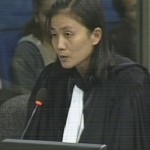
Moch Sovannary, Civil Party Co-Lawyer
Ms. Hun’s father was a teacher in Preah Sihanouk College in Kampong Cham Province. Ms. Hun, her father and two her two siblings (who were 16 and 18 at the time), were sent to the 1st January Dam worksite. They had no choice about where they were to work. Hun Sethany arrived at the dam in December, 1976, and stayed there until the rainy period of June or July, 1977, working in three different areas. Initially, she worked near the Trapaing Chrey Pagoda, then she was asked to dig soil near the national road, and, lastly, she helped build the 1st January Dam.
The witness’s group consisted of 50 female workers and about 30 to 40 male workers. There were both “base people” and “new people” in Ms. Hun’s group.
As a “new” person could not be a chief, Ann, a “base person” (now deceased) was chief of her unit. Children (age 13 to 19) at the1st Dam worksite were assigned to the second mobile unit.
At 4:00 p.m., the evidentiary hearings in Case 002/02 adjourned to continue on the morrow with the further testimony of Hun Sethany.
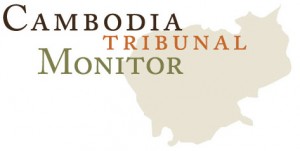
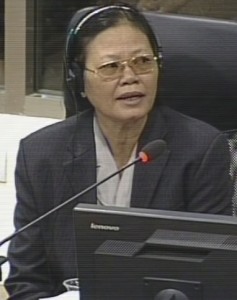
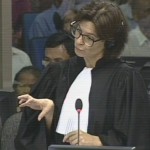
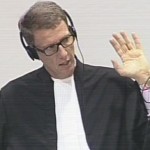
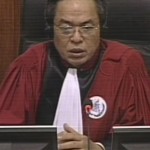
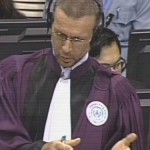
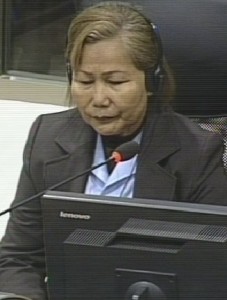
[…] Moch Sovannary, Civil Party Co-Lawyer, continued her examination started the day before, which you can read here. […]